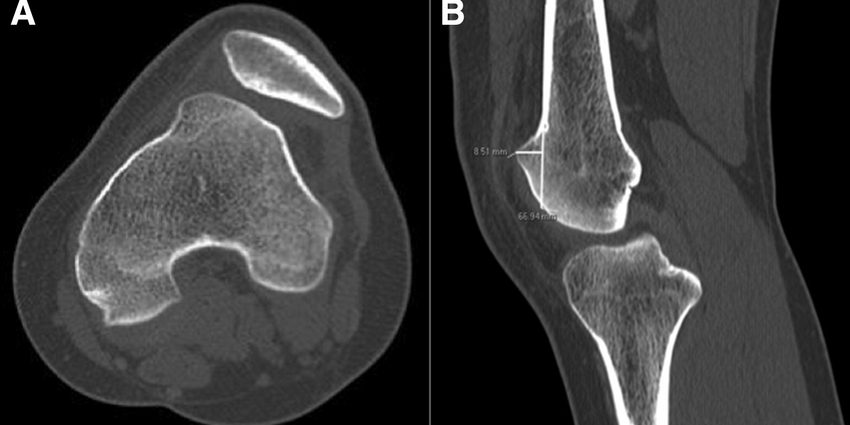Contents
- Knee CT scan: for what reasons and how is the examination carried out?
Knee CT scan: for what reasons and how is the examination carried out?
The knee scanner is a powerful examination, allowing a reliable analysis of the knee, in 3 dimensions. But, its indications are precise. It is particularly recommended for detecting an occult fracture or for making a precise assessment of a fracture.
The scanner: what is this exam?
The scanner is an imaging technique, which allows a much more precise analysis of the joints than an x-ray, offering better sharpness and a 3-dimensional visualization.
“The CT scan is not, however, a first-line examination of the knee,” explains Dr Thomas-Xavier Haen, Knee surgeon. Indeed, the scanner uses a relatively large dose of X-rays, and it should therefore only be requested if the other examinations (X-rays, MRI, etc.) have not made it possible to determine the diagnosis precisely. “
Indications for a knee CT scan
The scanner is especially effective for analyzing bone structures. “Thus, this is the exam of choice for:
- detect an occult fracture, that is to say not visible on standard radiographs;
- make a precise assessment of a fracture (for example: a complex fracture of the tibial plateau), before operation, ”continues the specialist.
“It can also be prescribed by the surgeon for:
- best plan operations such as surgery for dislocated patella (more common in adolescents),
- or before fitting a custom-made knee prosthesis ”.
Finally, it is an essential examination when a bone tumor is suspected.
CT arthrography: for more precision
Sometimes, if a meniscal or cartilage lesion is suspected, the doctor may order a CT arthrography. It is based on a conventional scanner, coupled with the injection of a contrast product into the joint, which will allow a more detailed analysis of the environment of the knee and reveal possible internal injuries.
For this injection, local anesthesia is performed to avoid pain during the injection of the contrast product.
The examination process
There is no specific preparation for having a knee scan. It’s a quick and easy exam that only takes a few minutes. As with any x-ray examination, the patient should remove any metallic object on the affected leg. He will then lie down on his back on an examination table. The table will move inside a tube and the ring of the scanner containing the X-rays will turn around in order to carry out the various acquisitions.
During the examination, the radiologist will speak to the patient via a microphone to reassure him and answer any questions.
“Before having a CT scan, it is important to tell the doctor if you are pregnant or think you may be, and if you are allergic to an iodinated contrast medium,” recalls Dr. Haen. “In this second case, we will use another contrast product.”
Specific situations (with or without injection, with or without prosthesis, etc.)
“Two thirds of the knee scans are performed without injection”, continues our interlocutor. But in some cases, for example if the MRI is inconclusive, a CT arthrography is prescribed, which additionally involves an injection of iodinated contrast product into the joint using a needle, in order to study the condition. content (menisci, cartilages…) more finely ”.
The injection of this product is not trivial: the patients can thus feel a sensation of heat in all the body, and the joint can react with swelling for a few days. Infection of the joint can occur, but this is exceptional.
In the case of a knee prosthesis
Another situation: the patient with a knee prosthesis. “A CT scan may sometimes be necessary to find the cause of a problem with a knee prosthesis (pain, blockages, etc.). It is a very useful examination, to detect a prosthesis which protrudes, a kneecap which dislodges, a prosthesis which becomes detached from the bone… ”. The only concern is the interference that the metal contained in the prosthesis can cause. This can complicate the interpretation of the images, so it is necessary for the radiologist to modify certain computer parameters.
Results and interpretations of a knee CT scan
With the delivery of the images, the radiologist will give a first report to the patient, allowing him to understand the severity, or not, of the situation. “The Doctor or the Surgeon who ordered the examination will also analyze these pictures, in order to indicate to the patient his conclusions and recommendations”, adds our interlocutor.
Price and reimbursement of a knee scan
The rates are set by the Health Insurance for professionals working in sector 1. On the basis of reimbursement, social security reimburses 70% of the act. The Mutual can then take charge of the remaining sum. In sector 2, practitioners can invoice the exam with an excess fee (generally paid for by the Mutual).










